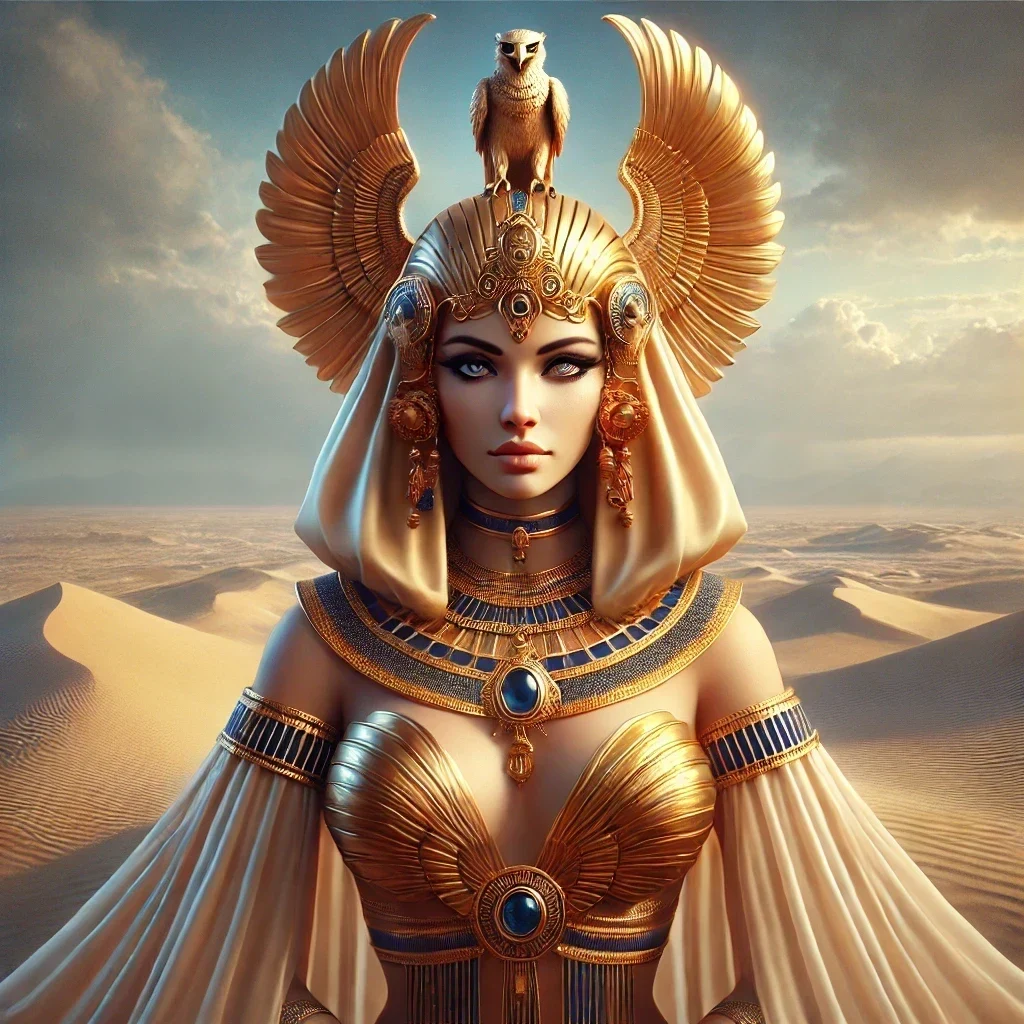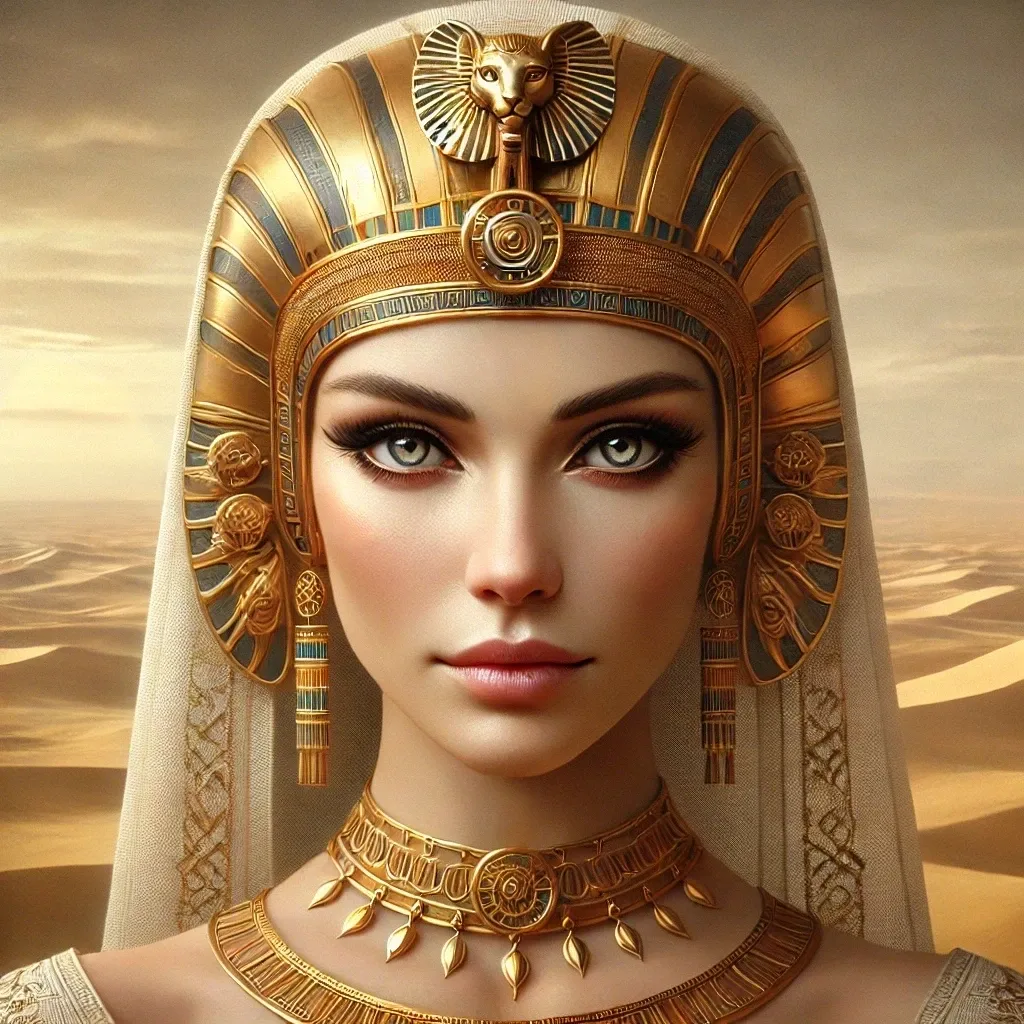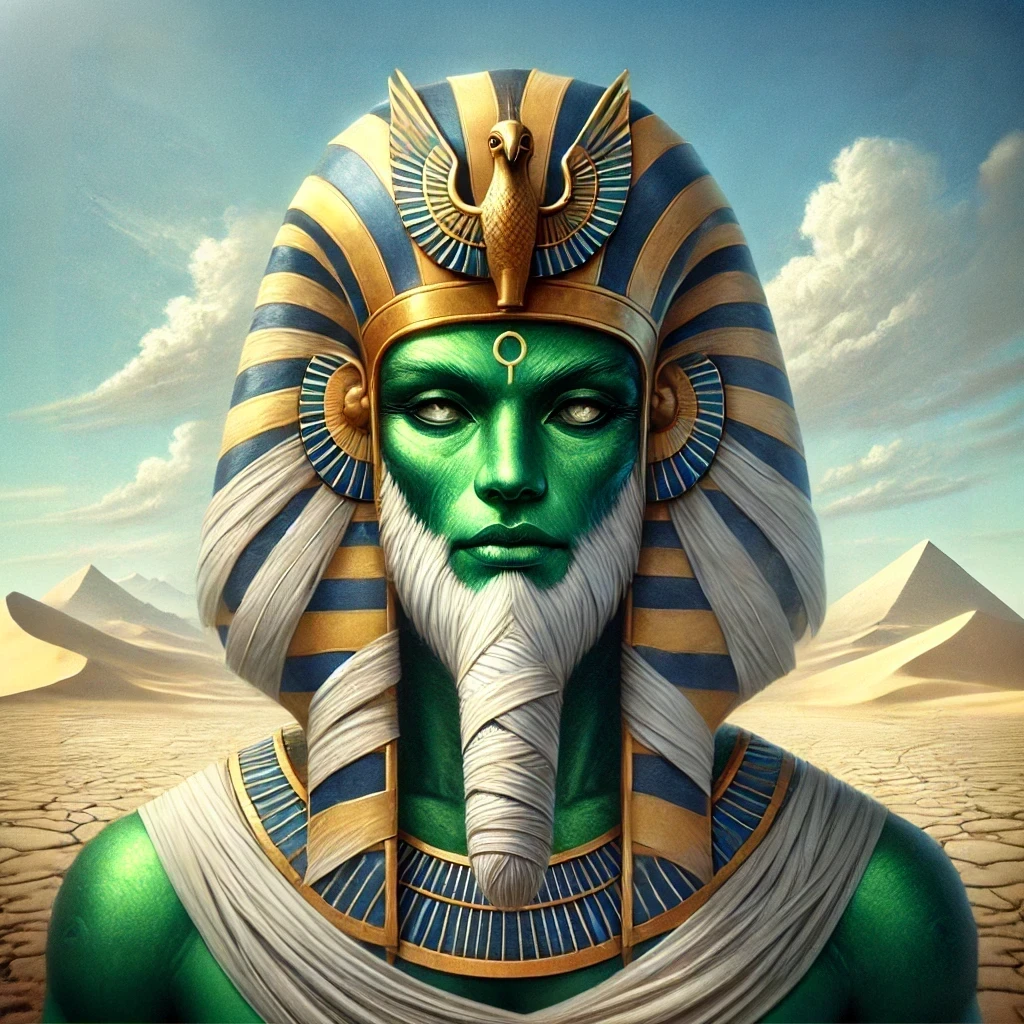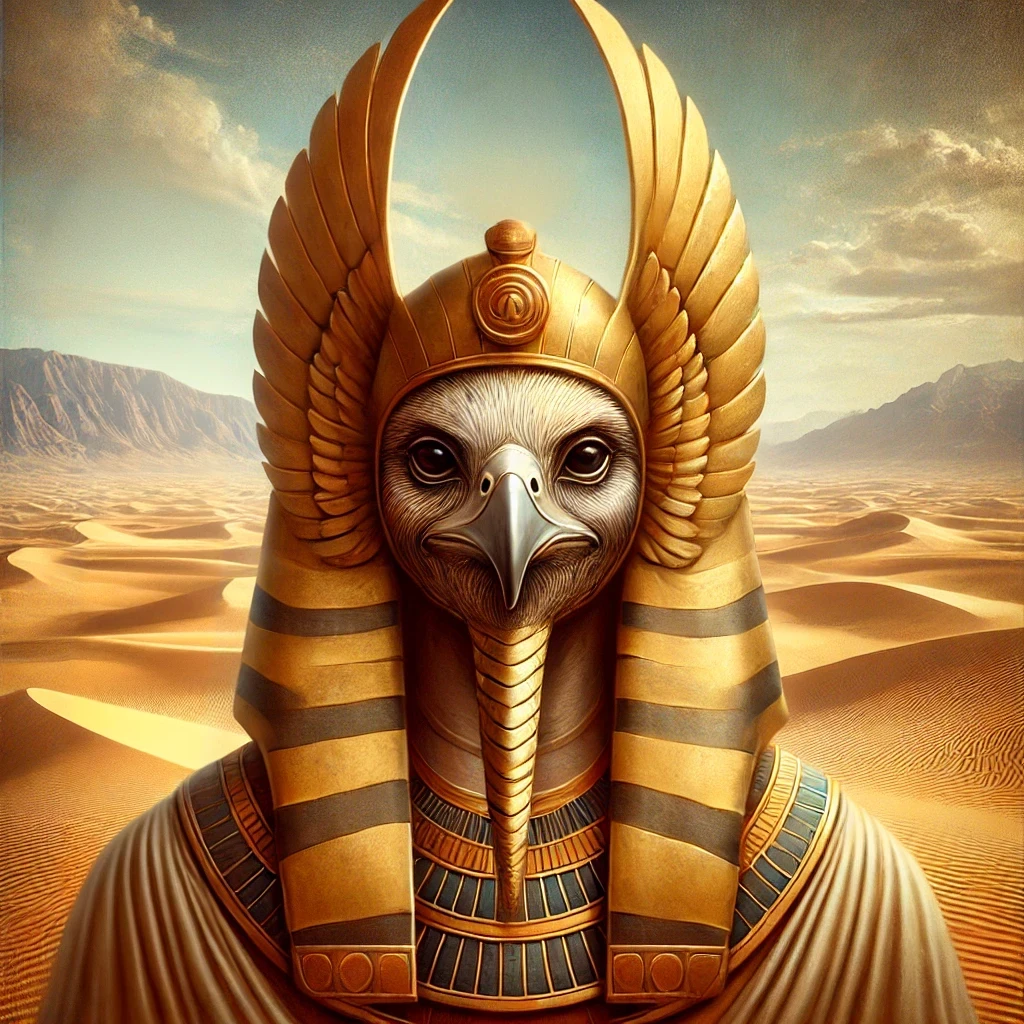Known as Nekhbet, her name derives from the ancient Egyptian city of Nekheb (modern El Kab), where her cult was centered. Often referred to as the “White Crown of Upper Egypt,” she was a guardian of the pharaohs and a symbol of maternal care. Her epithets, such as “She of Nekheb” and “Mistress of the Sky,” reflect her celestial and regal associations. As a primordial deity, her influence extended beyond the mortal realm, intertwining with the very fabric of Egyptian cosmology and kingship. Her enduring presence in art, myth, and ritual underscores her significance in one of history’s most enduring civilizations.
Origins
Early Depictions and Historical Roots
The origins of this vulture goddess can be traced back to the Predynastic Period (c. 6000–3150 BCE), a time when Egypt was divided into regional powers. Nekhbet’s association with Nekheb, a prominent city in Upper Egypt, suggests she was initially a local protector deity. Over time, her role expanded as the unification of Upper and Lower Egypt under the first pharaohs elevated her to a national symbol. Her vulture form, a creature revered for its protective and nurturing qualities, likely contributed to her early veneration.
Connection to Kingship
From the Early Dynastic Period (c. 3150–2686 BCE), she became intrinsically linked to the concept of kingship. As the patron deity of Upper Egypt, she was often paired with Wadjet, the cobra goddess of Lower Egypt, symbolizing the unity of the Two Lands. This duality was represented in the pharaoh’s regalia, where her image adorned the royal crown, signifying her role as a protector of the ruler and the state.
Evolution Over Time
Nekhbet’s prominence persisted through the Old Kingdom (c. 2686–2181 BCE) and into the New Kingdom (c. 1550–1070 BCE), though her role evolved. While she remained a guardian of the pharaoh, she also became associated with childbirth and motherhood, reflecting her nurturing aspects. This evolution highlights her adaptability within the Egyptian religious framework, ensuring her relevance across millennia.
Appearance
The Vulture Form
Nekhbet is most commonly depicted as a vulture, often with outstretched wings, symbolizing protection and shelter. The Egyptian vulture (Neophron percnopterus) was chosen for its maternal instincts and its ability to soar high above the earth, connecting her to the heavens. Her white plumage, representing purity and the divine, further emphasized her celestial nature.
Anthropomorphic Representations
In some depictions, she appears as a woman with the head of a vulture, wearing the White Crown of Upper Egypt. This anthropomorphic form underscores her dual role as a celestial and earthly protector. Occasionally, she is shown holding the ankh (symbol of life) and the scepter (symbol of authority), reinforcing her association with royalty and divine power.
Iconography in Art
Nekhbet’s imagery is prevalent in temple reliefs, tomb paintings, and royal insignia. She is often depicted hovering above the pharaoh, her wings spread in a protective gesture. In funerary contexts, she appears alongside other protective deities, safeguarding the deceased in their journey to the afterlife.
Abilities
Protector of the Pharaoh
As a guardian deity, Nekhbet’s primary role was to shield the pharaoh from harm. Her presence in royal iconography served as a constant reminder of her watchful gaze. She was believed to ward off enemies and evil forces, ensuring the stability and prosperity of the kingdom.
Nurturer and Life-Giver
Beyond her protective duties, she was also revered as a nurturer. Her association with childbirth and motherhood made her a patron of midwives and expectant mothers. In this capacity, she was invoked for safe deliveries and the health of newborns.
Divine Authority
Nekhbet’s connection to the White Crown of Upper Egypt granted her a role in legitimizing the pharaoh’s rule. By bestowing her favor upon the ruler, she reinforced the divine right of kingship, linking the mortal and divine realms.
Domain
Celestial Realm
As the “Mistress of the Sky,” her domain extended to the heavens. Nekhbet’s vulture form, soaring high above the earth, symbolized her ability to traverse the celestial and terrestrial worlds. This connection to the sky also linked her to the sun god Ra, further elevating her status.
Earthly Influence
On earth, her influence was felt in the royal court and the homes of ordinary Egyptians. As a protector of the pharaoh, she was integral to the state’s stability. Simultaneously, her role in childbirth and motherhood made her a household deity, revered by families across the land.
Funerary Role
In the afterlife, she played a crucial role in guiding and protecting the deceased. Her presence in tombs and funerary texts highlights her importance in ensuring a safe passage to the afterlife, where she continued her protective duties.
Myths
The Protector of Horus
One of the most enduring myths involving Nekhbet is her role in the protection of the infant Horus. According to legend, she and Wadjet shielded Horus from his uncle Seth, who sought to kill him. This myth underscores her role as a maternal protector and her connection to the divine lineage of the pharaohs.
The Unification of Egypt
Another significant tale involves her partnership with Wadjet in symbolizing the unification of Upper and Lower Egypt. Together, they represented the harmonious balance of the Two Lands, a theme central to Egyptian cosmology and political ideology.
The Divine Mother
In later periods, Nekhbet was associated with the myth of the divine mother who nurtures and sustains the cosmos. This narrative highlights her evolution from a local protector to a universal deity, embodying the principles of creation and renewal.
Symbolism
The Vulture
The vulture, Nekhbet’s primary symbol, represents protection, motherhood, and purification. Its ability to soar high above the earth also connects it to the heavens, reinforcing her celestial associations.
The White Crown
The White Crown of Upper Egypt, often depicted in her iconography, symbolizes her role as a protector of the pharaoh and the unity of the Two Lands. It also signifies purity and divine authority.
The Ankh and Scepter
The ankh and scepter, frequently held in her anthropomorphic form, represent life and authority. These symbols emphasize her dual role as a nurturer and a guardian of kingship.
Worship
Temples and Shrines
Nekhbet’s primary cult center was in Nekheb, where a temple dedicated to her stood. Smaller shrines and altars were also erected in her honor throughout Egypt, particularly in areas associated with childbirth and motherhood.
Rituals and Offerings
Worshipers offered prayers, food, and votive objects to gain her favor. Rituals often involved the use of vulture imagery and the recitation of hymns praising her protective and nurturing qualities.
Festivals
Though specific festivals dedicated to her are not well-documented, she was likely honored during royal coronations and state ceremonies. Her presence in these events underscored her role in legitimizing the pharaoh’s rule.
Associations
Wadjet
Nekhbet’s most significant association is with Wadjet, the cobra goddess of Lower Egypt. Together, they symbolized the unity of the Two Lands and were often depicted flanking the pharaoh or the sun disk.
Horus
As a protector of Horus, she is closely linked to the falcon god, reinforcing her role in safeguarding the divine lineage of the pharaohs.
Mut
In later periods, she was associated with Mut, the mother goddess of Thebes. This connection further emphasized her nurturing aspects and her role in the broader Egyptian pantheon.
Legacy
Decline in Prominence
With the rise of Christianity and the decline of traditional Egyptian religion, Nekhbet worship gradually diminished. However, her imagery and symbolism persisted in Coptic art and Christian iconography, reflecting her enduring influence.
Modern Rediscovery
Today, she is studied by historians and archaeologists as a key figure in ancient Egyptian religion. Her depictions in art and inscriptions continue to provide insights into the beliefs and practices of one of the world’s oldest civilizations.
1. The Vulture’s Maternal Instincts: The Egyptian vulture, which inspired her form, was revered for its nurturing behavior. Unlike many birds, both parents care for their young, a trait that likely contributed to her association with motherhood and protection.
2. A Dual Crown: While she is most commonly linked to the White Crown of Upper Egypt, she was sometimes depicted wearing the Double Crown (Pschent), symbolizing her role in unifying Upper and Lower Egypt alongside Wadjet.
3. The Eye of Ra Connection: In some texts, she is identified as an aspect of the Eye of Ra, a powerful symbol of divine fury and protection. This association further elevated her status as a guardian deity.
4. A Protector of the Dead: In addition to safeguarding the living, she was believed to protect the deceased in the afterlife. Her image often appeared on the ceilings of tombs, symbolizing her watchful presence over the dead.
5. The Milk of Nekhbet: In one obscure myth, she was said to provide divine milk to the pharaoh, nourishing him with her celestial essence and ensuring his divine right to rule.
6. A Symbol of Purity: Her white vulture form was not only a symbol of protection but also of purity. This association made her a fitting guardian for sacred spaces and rituals.
7. The Nekhbet Amulet: Small amulets depicting her vulture form were worn by pregnant women and new mothers to invoke her protection during childbirth and infancy.
8. A Goddess of the Harvest: In some regions, she was associated with the annual flooding of the Nile and the subsequent harvest, linking her to fertility and abundance.
9. The Winged Sun Disk: She is often depicted alongside Wadjet as part of the winged sun disk, a symbol of divine power and protection that adorned temples and royal insignia.
10. A Forgotten Temple: While her primary temple was in Nekheb, archaeologists have discovered remnants of a lesser-known shrine dedicated to her in the ancient city of Hierakonpolis, highlighting her widespread veneration.



